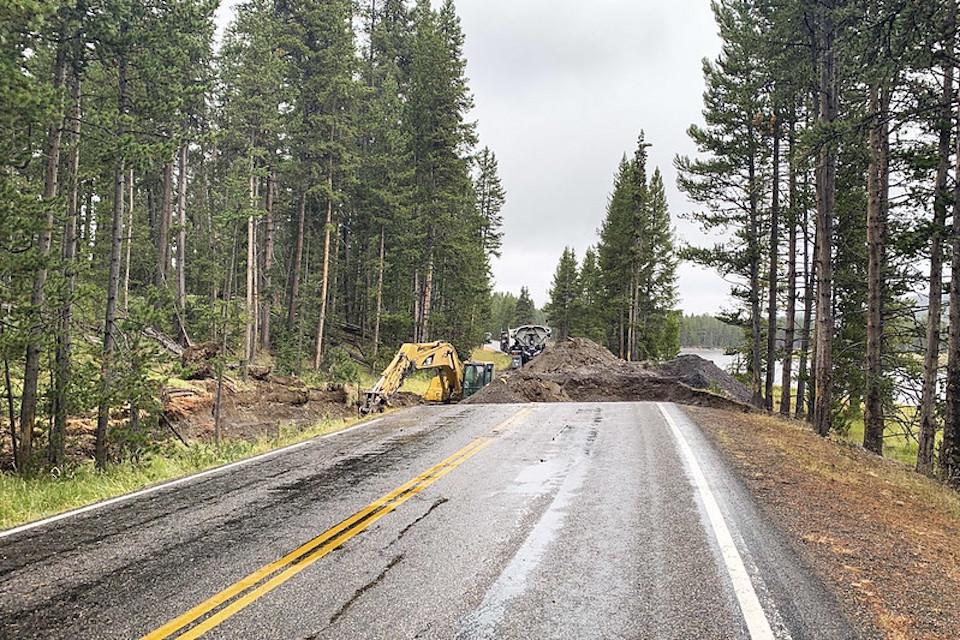
A hole 100 feet wide, 100 feet long, and 10 feet deep was dug in Yellowstone to clean up soils contaminated by a 3,000-gallon gasoline spill/NPS, Cam Sholly
It could take a week before the road between Mud Volcano and Fishing Bridge Junction in Yellowstone National Park reopens, as cleanup of a gasoline spill involved digging a 100-foot wide, 100-foot-long, and 10-foot-deep hole, the park announced Tuesday evening.
The large hole was needed to remove contaminated soil, a park release said.
"Excavated materials contaminated with gas will be removed from the park and disposed of at an appropriate facility," it added. "The park is coordinating with the Wyoming Department of Environmental Quality on cleanup efforts."
The park has not said exactly what caused the accident, which resulted in the largest roadside fuel spill in Yellowstone in nearly 20 years, the release noted. It doesn't appear that any of the gas reached the Yellowstone River, it added.
"While the commercial motor vehicle was transporting unleaded gasoline to facilities in the park, the tandem trailer rolled over on the west side of the road," the release said.
While the road remains closed, the Mud Volcano area is only accessible from the north and Fishing Bridge Junction is only accessible from the south and from the East Entrance.

The tanker truck was hauling gasoline to park service stations when it rolled/NPS file



Comments
It's instructive to see the top photo, looking at the accident site from the south, rather than just the bottom photo, which shows the accident site looking from the north. Looking from the south, you can see how close this spill was to the river and how far the ground surface where the spill occurred is above the river level. That difference in elevation determines the amount of static head that gasoline has behind it.
A spill of 3,000 gallons is a spill in excess of fifty barrels and that gasoline, being exceptionally mobile, immediately started spreading not just straight down, but laterally through that predominently mineral soil. A 100 foot wide, 100 foot long, 10 foot deep hole might seem like quite a hole; but, depending on how long it took them to start chasing that gasoline, that seemingly large hole might only be an initial guess at the amount of soil they may ultimately need to remove in order to do a genuinely good job of cleaning up this fiasco.
And, let's hope that's not contaminated soil they've stockpiled over onto the exposed ground on the river side of the road. That would be counterproductive, especially since the road is already closed in both directions and they have all the pavement they need on which to pile excavated contaminated soils.
The point is that this might not be the Exxon Valdez; but, neither is it an insignificant spill and the disruption and remediation costs won't be insignificant either. This should be enough of a lesson learned to result in banning of use of tandem trailer rigs in the park, especially those hauling hazardous materials. It should be single trailer rigs only in the future. Let's see if that lesson takes.
I agree. Tandem Fuel Trucks must be banned from all NPS units. Too much at stake with tight roads, surface water, ground water, etc. This is why all trucks including fuelers are discouraged from traveling Oregon State Route 242 (Mackenzie Pass). Top of Mackenzie Pass is all volcanic. It's gorgeous up there. Yet, Mackenzie Pass is also a vast entrance to one of greatest aquifer systems in Oregon. Snowmelt in Spring/Summer heads straight down and feeds the headwaters of the Mackenzie River, Proxy Creek, and Deshurts River Basin creeks. A fuel spill here would be a complete disaster that would immediately hit the groundwater aquifer. protect our parks and wild areas from unneeded fuel spills.
What is done with the excavated soil?
What is done with the excavated soil? Third paragraph of article: "Excavated materials contaminated with gas will be removed from the park and disposed of at an appropriate facility," in coordination with Wyoming Department of Environmental Quality.
Thx - I'd missed that paragraph.
Talk about a crazy Labor Day Weekend in Yellowstone, both for the visitor and the staff. My wife and I were camping in Canyon and made our way down the Norris, Madison, Old Faithful Grand Loop to Grant Village just hours before the Lonestar Fire closed the Old Faithful-Grant stretch, essentially cutting off traffic from going north to south and vice versa. At about 5PM on Saturday 9/5, we drove to the Grant Village Junction to witness the confusion and the amazing skies the smoke from Lonestar created. We approached three rangers at the intersection and one of them was Cam Sholly, YNP superintendent. He shared with us how many crazy things he and the staff had to deal with this summer - COVID, bridge to Old Faithful being damaged causing closure and creating a four way stop for entrance and exit, major water line break near Mammoth, the Lonestar Fire and semi-trailer gasoline spill essentially cutting the park in half, and then the first heavy snow-fall forecast for the park (today's webcam showed little snow - whew!) as people were leaving after the Labor weekend. I am sure there were many more mini-disasters that didn't make the headlines. Thanks Cam for your leadership and the countless hours put in by park staff, employees and contractors for making a near epic disaster into just another enjoyable walk and week in the park!